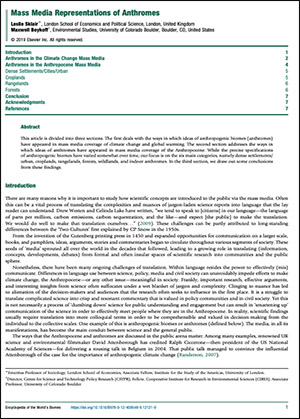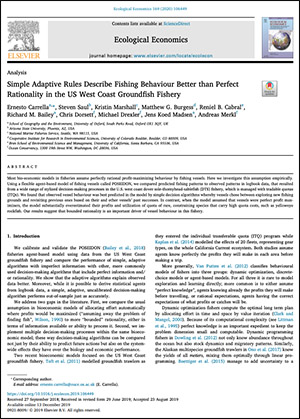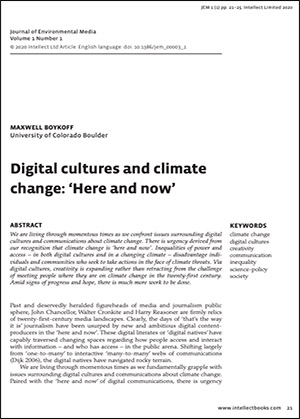CENTER Publications
Below is a sample of recent publications by CSTPR faculty (Center personnel highlighted):
|
 How experiences of climate extremes motivate adaptation among water managers How experiences of climate extremes motivate adaptation among water managers
Page, R. and L. Dilling, 2020. Climatic Change, doi: 10.1007/s10584-020-02712-7.
Abstract: As water systems are likely to experience mounting challenges managing for climate variability and extremes as well as a changing climate, there is increasing interest in what motivates systems to implement adaptive measures. While extreme events have been hypothesized to stimulate organization change and act as “windows of opportunity” and “pacemakers” driving toward adaptation, they do not always seem to do so. We therefore sought to understand the responses and motivations for organizational behavior in the wake of two significant droughts across five smaller water systems in Western Colorado, USA. We conducted interviews and focus groups across these systems to understand whether and why significant droughts in 2002 and 2012 prompted adaptive change. Results indicate that systems did not uniformly decide to change their policies in the wake of drought, and even well-prepared systems were driven to change policies by other pressures, such as peer-system pressure and political pressure from residents. We find that organizational worldviews were important mediators of how the experience of drought manifest, or not, in organizational changes. These findings have implications for assumptions about what might drive organizational learning and change among water managers for climate adaptation in the future. Read more ... |
 Mass media representations of Anthromes Mass media representations of Anthromes
Sklair, L. and M. Boykoff, 2020. Encyclopedia of the World’s Biomes: Reference Module in Earth Systems and Environmental Sciences, Ed. M. Goldstein and D. DellaSala, Elsevier, doi: 10.1016/B978-0-12-409548-9.12121-9.
Abstract: This article is divided into three sections. The first deals with the ways in which ideas of anthropogenic biomes (anthromes) have appeared in mass media coverage of climate change and global warming. The second section addresses the ways in which ideas of anthromes have appeared in mass media coverage of the Anthropocene. While the precise specifications of anthropogenic biomes have varied somewhat over time, our focus is on the six main categories, namely dense settlements/urban, croplands, rangelands, forests, wildlands, and indoor anthromes. In the third section, we draw out some conclusions from these findings. Read more ... |
 Opportunities for agent-based modelling in human dimensions of fisheries Opportunities for agent-based modelling in human dimensions of fisheries
Burgess, M.G., E. Carrella, M. Drexler, et al, 2020. Fish and Fisheries, doi: 10.1111/faf.12447.
Abstract: Models of human dimensions of fisheries are important to understanding and predicting how fishing industries respond to changes in marine ecosystems and management institutions. Advances in computation have made it possible to construct agent-based models (ABMs)—which explicitly describe the behaviour of individual people, firms or vessels in order to understand and predict their aggregate behaviours. ABMs are widely used for both academic and applied purposes in many settings including finance, urban planning and the military, but are not yet mainstream in fisheries science and management, despite a growing literature. ABMs are well suited to understanding emergent consequences of fisher interactions, heterogeneity and bounded rationality, especially in complex ecological, social and institutional contexts. For these reasons, we argue that ABMs of human behaviour can contribute significantly to human dimensions of fisheries in three areas: (a) understanding interactions between multiple management institutions; (b) incorporating cognitive and behavioural sciences into fisheries science and practice; and (c) understanding and projecting the social consequences of management institutions. We provide simple examples illustrating the potential for ABMs in each of these areas, using conceptual (“toy”) versions of the POSEIDON model. We argue that salient strategic advances in these areas could pave the way for increased tactical use of ABMs in fishery management settings. We review common ABM development and application challenges, with the aim of providing guidance to beginning ABM developers and users studying human dimensions of fisheries. Read more ... |
 What unmanaged fishing patterns reveal about optimal management: Applied to the balanced harvesting debate What unmanaged fishing patterns reveal about optimal management: Applied to the balanced harvesting debate
Burgess, M.G. and M.J. Plank, 2020. ICES Journal of Marine Science, doi: 10.1093/icesjms/fsaa012.
Abstract: Balanced harvesting (BH)—the idea of harvesting all species and sizes in proportion to their production rate—has been a topic of recent debate. Developed world fisheries tend to fish more selectively, concentrating on certain species and sizes preferred in the market. However, fishing patterns in some developing countries, with a range of different fishing gears and more generalist markets, more closely resemble BH. The BH debate therefore hinges on whether selective fisheries should become more balanced, whether unselective fisheries should do the opposite, both, or neither. In this study, we use simple and general analytical theory to describe the ideal free distribution that should emerge in unmanaged fisheries, and we show that this ideal free distribution should approximately produce BH only when prices, catchabilities, and fishing costs are similar across species and sizes. We then derive general properties of yield and profit maxima subject to conservation constraints. We find that BH is unlikely to be optimal in any fishery but may be closer to optimal in fisheries in which it emerges without management. Thus, BH may be more useful as a heuristic for understanding differences between fisheries in locally appropriate management than as an exact management strategy. Read more ... |
 Simple Adaptive rules describe fishing behaviour better than perfect tationality in the US West Coast Groundfish Fishery Simple Adaptive rules describe fishing behaviour better than perfect tationality in the US West Coast Groundfish Fishery
Ernesto Carrella, E., S. Saul, K. Marshall, M.G. Burgess, et al., 2020. Ecological Economics 169, doi: 10.1016/j.ecolecon.2019.106449.
Abstract: Most bio-economic models in fisheries assume perfectly rational profit-maximizing behaviour by fishing vessels. Here we investigate this assumption empirically. Using a flexible agent-based model of fishing vessels called POSEIDON, we compared predicted fishing patterns to observed patterns in logbook data, that resulted from a wide range of stylized decision-making processes in the U.S. west coast dover sole-thornyhead-sablefish (DTS) fishery, which is managed with tradable quotas (ITQs). We found that observed vessel behaviour was best predicted in the model by simple decision algorithms whereby vessels chose between exploring new fishing grounds and revisiting previous ones based on their and other vessels’ past successes. In contrast, when the model assumed that vessels were perfect profit maximizers, the model substantially overestimated their profits and utilization of quota of rare, constraining species that carry high quota costs, such as yelloweye rockfish. Our results suggest that bounded rationality is an important driver of vessel behaviour in this fishery. Read more ... |
 Digital cultures and climate change: ‘Here and now’ Digital cultures and climate change: ‘Here and now’
Boykoff, M., 2020. Journal of Environmental Media 1 (1) 21-25, doi: 10.1386/jem_00003_1.
Abstract: We are living through momentous times as we confront issues surrounding digital cultures and communications about climate change. There is urgency derived from our recognition that climate change is ‘here and now’. Inequalities of power and access - in both digital cultures and in a changing climate - disadvantage individuals and communities who seek to take actions in the face of climate threats. Via digital cultures, creativity is expanding rather than retracting from the challenge of meeting people where they are on climate change in the twenty-first century. Amid signs of progress and hope, there is much more work to be done. Read more ... |
